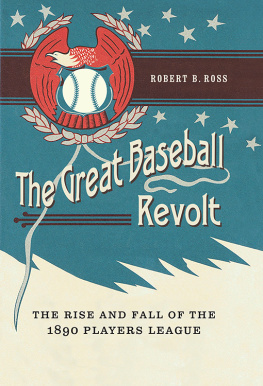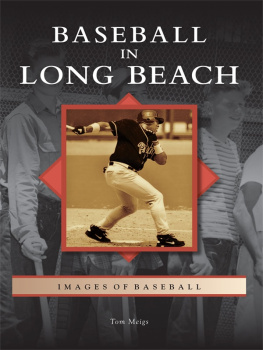
SACRAMENTO
BASEBALL
FRONT COVER: This c. 1924 photograph shows Earl McNeeley, a Sacramento native born in 1898 and one of Sacramentos great ballplayers. Known for his speed, he played center field for the Washington Senators and was the hero of the 1924 World Series when he drove in the winning run of Game 7 in the 12th inning. He played for Pacific Coast League (PCL) Sacramento in 1922 and part of 1924 then played in the American League for eight years. When he returned to Sacramento in 1932, he became the Sacramento Senators manager and eventually the teams owner. (Courtesy of Sacramento Public Library, Sacramento Room Special Collections.)
COVER BACKGROUND: The Sacramento Solons posed for this photograph at Edmonds Field in 1949. After finishing in last place in the Pacific Coast League in 1948, the team returned in 1949 to finish third. They year 1949 was the first year the Solons played at their new ballpark following the July 1948 fire. (Courtesy of Sacramento Public Library, Sacramento Room Special Collections.)
BACK COVER: This photograph shows the 1921 Heeseman Clothiers Winter League team. Pictured are, from left to right, (first row) Howard Foote (pitcher), Danny Wright (pitcher), Bill Keenan (pitcher), Bobby Schang (right field), Frank Tobin (catcher), and Clif Derringer (second base); (second row) Al Hutchinson (manager), Bob Nixon (left field), Guy Wright (center field), Earl Kunz (pitcher), Arthur Luddy (third base), Tommy White (short stop), George Gibson (pitcher), Reese Peek (pitcher), and Frank Gerig (first base). (Courtesy of GoodOldSandlotDays.com.)
SACRAMENTO
BASEBALL

William D. McPoil

Copyright 2017 by William D. McPoil
ISBN 978-1-4671-1710-4
Ebook ISBN 9781439659564
Published by Arcadia Publishing
Charleston, South Carolina
Library of Congress Control Number: 2016945811
For all general information, please contact Arcadia Publishing:
Telephone 843-853-2070
Fax 843-853-0044
E-mail
For customer service and orders:
Toll-Free 1-888-313-2665
Visit us on the Internet at www.arcadiapublishing.com
To Myles and Mason Hammond, baseball players, fans, and fantastic grandsons.
CONTENTS
ACKNOWLEDGMENTS
I now understand why so many authors acknowledge their spouse at the beginning of a book. My wife, Gayle, has encouraged and supported me from the proposal submission to completion. I cannot thank her enough.
The images in this book, and the descriptions that go with them, came to me from many sources. I got started with photographs from the Sacramento Room at the Sacramento Public Library. Amanda DeWilde and the other librarians provided me with photographs dating from the Gilt Edge through the Sacramento River Cats. Tim Armstrong, the grandson of Tony Freitas, gave me photographs and information about Freitas and the Sacramento Solons that I am sure I could not have found anywhere else. Alan OConnor, Sacramentos true baseball historian, helped me populate the chapters on the early days of Sacramento baseball and the chapter on the Sacramento Solons. Kerry Yo Nakagawa, director of the Nisei Baseball Research Project, helped me start on the chapter about Nisei baseball with images and provided me with historical information I used throughout that chapter. Norman Blackwell Sr. provided me photographs of the Golden Seniors, amateur and semipro baseball, and several of the photographs of equipment. Julie Thomas at California State University (CSU), Sacramento Special Collections was a tremendous help with the CSUSacramento photographs and several of the photographs in the Nisei chapter. Sacramento River Cats general manager Chip Maxson gave his support from the very beginning, and Erin ODonnell and Amanda Holland at the Sacramento River Cats opened the River Cats photograph archives to me. I spent too many hours to count at the Arden Fair Apple store where Katja, Marquita, River, Stephanie, and Sherelle answered many questions when I was composing the photographs and text. The others, too numerous to include here, deserve to be thanked and have been both personally and by crediting their photographs in the following pages.
Of course, Alyssa Jones, the acquisitions editor who worked so hard to help me get the project approved, and Henry Clougherty, my title manager, who worked with me through many e-mails and telephone conversations to bring the book to publication, deserve special thanks.
INTRODUCTION
Although organized and recreational baseball had been played in the Sacramento area since the Gold Rush, according to Sacramento baseball historian Alan OConnor, the Sacramento Daily Union published the first written record of professional baseball in the capitol city in 1859. Ten years later, in September 1869, the Cincinnati Red Stockings, the first recognized professional baseball team in America, came to Northern California and played against the Pacifics, a local team in San Francisco, and then went to Sacramento, where a team was organized to play against them. Although the game was enjoyed by the crowd that turned out, the local squad lost by a score of 50-6.
A decade after that, in 1879, the California League was established. It is recognized as the first professional league in the state. It was comprised of teams from San Francisco and Oakland Oakland Pioneers, San Francisco Athletics, San Francisco Californias, and the San Francisco Mutuals. Seven years later, in 1886, the league was expanded. With that expansion, the league now included the Oakland Greenhood and Morans, the San Francisco Haverlys, the San Francisco Pioneers, the San Francisco Star, and the Sacramento Altas. The Altas played at Agricultural Park in downtown Sacramento and later at Snowflake Park, still in the downtown grid but a few blocks south and east.
In 1890, the Altas were renamed the Senators as a reference to their location in the states capital. They competed for a couple of years, but unfortunately for baseball fans, Sacramento did not field a team in the middle of the decade. However, in 1898, a local brewery, Ruhstaller Brewery, sponsored a new team, naming it after their best-selling lager, Gilt Edge, and bringing organized baseball back to town. The Gilt Edge posted impressive numbers in their first three years, winning league championships in 1898, 1899, and 1900. In 1901, the team was again renamed the Senators and finished third in a four-team league.
A new league, the Pacific Coast League, was formed in 1903, becoming the West Coasts answer to major league baseballs two eight-team leagues in the East. The league was formed as an independent league, and the Sacramento Senators was one of the six founding members that represented cities from Los Angeles to Seattle. As if the name change was not confusing enough, in 1906 and 1907, the teams name became the Sacramento Cordovas, having been named for Cordova wine produced by the California winery. The name changed back to the Senators in 1908, and that team became the 1909 Pacific Coast League Senators and stayed that way until 1936.
In 1936, the team was purchased by the St. Louis Cardinals. Branch Rickey, the Cardinals business manager, expanded player development and pioneered the minor league farm system we recognize today as affiliates of major league clubs. Since Solons had been used casually by sports writers since before World War I, the name was changed officially with the purchase by the Cardinals, and the Sacramento Solons name stayed with the team until they left in 1960 and again for the brief period in the 1970s when they returned.
Next page












